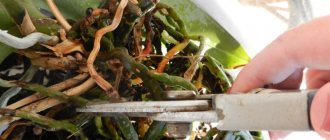Spring flowers (tulips, crocuses, muscari, daffodils) delight with bright, but not long-lasting flowering. Crocuses are one of the most popular bulbous primroses among gardeners. Their flowering lasts about a week, then the plant goes into a dormant state. What is the further care for crocus?
There is no need to annually dig up crocuses that bloom in early spring. If the flowers are healthy and bloom profusely, they can be left undisturbed for 5 years. Later, the curtain grows and needs to be divided, transplanting the corms to a new area.
Autumn crocuses (varieties that bloom in late summer) are not dug up annually. Once every five years, the overgrown clumps are divided.
Experienced gardeners advise digging up crocuses after flowering has ended if there has been poor flowering or the foliage does not look healthy. Bulbs sitting in the soil can be affected by infection or pests.
When to dig up crocuses
Different climatic conditions in our country dictate different timing for gardening. Crocuses begin to be dug up when the foliage of the plant falls to the ground and turns completely yellow. Approximate timing for removing spring crocuses from the soil:
- in the middle zone and Moscow region, excavation begins in early July;
- in the southern regions and in Ukraine - a month earlier, in June;
- in the Urals and Siberia - at the end of July.
Autumn crocuses for transplantation are dug up from late June to mid-August. The plants will bloom next year.
Do I need to dig up crocuses if they haven't bloomed?
@Taratorki
The lack of flowering in bulbous plants may indicate problems associated with a poorly chosen location or incorrect planting depth of the bulbs. Replanting the plant can correct the situation.
For crocus, choose sunny areas with well-drained, loose soil and deep groundwater. In the shade, the flower will only grow leaves, but not buds.
When planting, a full complex of mineral fertilizer for bulbous plants is applied to the soil. Low nutrient content in the soil is one of the signs of lack of flowering.
The correct depth for planting a corm in the ground is three times its height. Shallow planting leads to freezing of the bulbs in winter, and deep planting depletes the plant - all the strength of the sprout is spent breaking through the thickness of the earth in order to reach the surface; there is not enough strength for flowering.
For transplant
When a clump of crocuses grows, the plants become crowded. Leaves and flowers become smaller, flowering weakens. It's time to plant crocuses, separating the daughter bulbs from the mother bulbs.
Depending on the variety and the bulb planting pattern (loose or thickened), replanting begins every 3-5 years.
What you need to know about caring for corms if crocus blooms in the garden
Most often, gardeners grow plants that bloom in the spring, less often in the fall. Taking care of the corms in the first case depends on whether you want to transplant the flowers to another location or not. If not, then just remove the wilted leaves. In this case, it is not necessary to dig up the bulb, as it tolerates frost well. If the winter in your region is especially cold, you can later cover the flowerbed with branches or fallen leaves.
If you are going to transplant some of the bulbs to a new place or start forcing crocuses for early flowering, then you need to dig them up in July. Focus on the condition of the leaves: while they are green, the root continues to receive the necessary nutrition for future flowering and it is undesirable to interfere with this process. As soon as the leaves have withered, the bulbs need to be dug up and carefully examined. Damaged or shriveled ones cannot be replanted. Only the largest and healthiest ones should be left, without signs of rot or softness. For storing crocuses, well-ventilated rooms are chosen, the air temperature in which is in the range from 18 to 22 degrees.
Unlike other bulbous plants, crocuses do not need regular replanting, but do require fertilizer. You can dig up the bulbs after three to five years to renew the flower bed and add fertilizer to the soil for more luxuriant flowering.
The process of digging crocus bulbs
Choose dry weather for work. Dig up a clump of crocuses using a pitchfork, carefully removing the cluster of bulbs along with a lump of earth.
Beacons will help you not to lose the location of the crocuses when the foliage withers. These can be plastic disposable knives stuck near the plants.
On a piece of film or tarpaulin, the earthen ball is carefully broken down and all the corms are removed. They are cleared of soil and the roots are trimmed with pruning shears.
Experienced gardeners recommend eroding the earthen ball using a stream of water from a hose. This way there is less risk of damaging the bulbs.
Crocus corms are dried in the shade and sorted. All planting material with signs of deterioration: rot, mold, sores must be destroyed. Healthy-looking bulbs are pickled in a solution of phytosporin, Maxim, or a pink solution of potassium permanganate.
Video recommendations from the Marina Flowers channel
What to do with a plant after it has bloomed at home
After the flower has bloomed, the bulb releases castings and can form children. It can be planted in the garden or left in a pot. In the latter case, re-blooming will be a little later and not so beautiful. Watering a house plant is completely stopped from the moment the leaves die, somewhere in July-August. In September, it is recommended to transplant the bulb into a new nutrient substrate and start growing again.
Storing crocuses before planting
Crocus planting material is stored in a dry and warm place until planting. The bulbs are scattered into cardboard boxes, according to the varieties, in one layer. The boxes are placed in a room with good ventilation and a temperature of +20 degrees.
Shortly before planting in the ground (a week to ten days), it is recommended to reduce the storage temperature to +15 degrees.
Elena Chursinova A practical gardener with twenty years of experience. I prefer organic farming and lazy gardening. ...
Crocuses have bloomed: your actions
Until now, there is no single opinion among flower lovers on this matter.
Aries man and Pisces woman: compatibility of zodiac signs
Some believe that after flowering, the bulbs must be collected , their condition assessed, spoiled ones should be thrown away, and healthy ones should be disinfected (for example, soaked in a pink solution of potassium permanganate and dried, although such a procedure is not necessary).
Others say: there is no need to dig up the bulbs every year ; they overwinter well in the ground. True, in five years their “nest” will grow greatly - that’s when you can pick up a shovel. Moreover, the bulbs can either be completely transferred to a new location, or simply divided: some can be left in the old “nest”, and others can be transplanted.
When should you dig up bulbs?
It all depends on the type of flowers.
- Autumn-flowering varieties are dug from June to August.
- Spring crocuses are removed from the ground from July to September.
In any case, look at the plant: flowering should end and the leaves should turn completely yellow.
Be careful: crocus roots are fragile.
How to store them in winter?
First of all, after removing the bulbs from the ground, they need to be meticulously inspected. Immediately discard rotten and lethargic ones - by placing a single rotten onion in a common box, you will doom all the others.
Planting material needed:
- clean off stuck earth,
- dry it a little
- free from the upper scales,
- trim, removing broken, dry roots,
- disinfect if there is mechanical damage, that is, scratches without rot (ash or crushed charcoal or activated carbon are suitable for this).
Store the bulbs in a basket or box, placing it in a cool place. Make sure that they are not exposed to water (including condensation), as well as sunlight. It is important that the planting material does not freeze. The room (closet) should be about 22 degrees. By the way, before planting, the bulbs can be hardened by moving them to a room with 15 degrees.
A good container option for bulbs: a box made of wood or thick cardboard. If you have several varieties or types of bulbous plants, do not forget to attach a note to each “pile” or cell with the specified variety, as well as the date of collection.
There is no need to cover the box with a lid; the planting material must breathe. Place the bulbs in a loose layer.
Planting for forcing
Some gardeners grow crocuses at home in winter using the forcing method. At the same time, the indoor flower requires other conditions. Most often, large-flowered Dutch hybrids are grown by forcing.
It is necessary to outline the expected flowering date, and 3.5–4 months before the scheduled date, plant the bulbs in wide, shallow containers of 5–10 pieces. The soil for planting crocuses in pots should have good moisture and air permeability, be loose and have a neutral environment.
Flowers in a pot are kept in a place with a temperature of 5 to 10 ° C (this can be the bottom shelf of the refrigerator, basement, cellar). Two weeks before the expected flowering date, the temperature is raised: the pot is moved to the coolest place in the house, then to a warmer room, and finally, the flowers are placed in the sun on the windowsill. They will bloom soon.
When the bulbs are tightly arranged in a pot, you can get a beautiful bouquet of crocuses.
Diseases and pests
Crocuses are quite disease resistant. And among the pests, the greatest damage is caused by rodents that eat the bulbs. Mice and moles can gnaw them, which leads to rotting and death of the plant. If the flower looks depressed, you should dig it up and carefully examine the bulb. If damage is detected, they are sprinkled with ash or crushed activated carbon and left for 2-3 hours.
If rotten areas are found, they are cut off and the same procedure is carried out. To prevent damage by rodents, the bulbs are planted in special plastic baskets, ultrasonic repellers are installed in the garden, mechanical “turntables”, etc.
The larvae of click beetles (wireworms) also like to feast on crocuses, eating holes in the bulbs. The best way to get rid of them is to make traps. At the end of spring, bunches of unrotted grass, straw or hay are laid out around the area, moistened and covered with boards. The larvae crawl into them. After 2-3 days, the traps are collected and burned along with the pests at the stake.
If slugs are found on saffron, they are collected by hand. For prevention during planting, the bulb is surrounded by a layer of coarse sand. Gray spots on not fully opened flat petals indicate a viral disease. Such specimens must be dug up and destroyed as soon as possible. The soil is disinfected with a hot solution of potassium permanganate.
Warm and damp weather can provoke the appearance of gray rot and fusarium, which penetrates through wounds in the bulbs. To prevent the development of fungal diseases, healthy bulbs without damage are selected for planting. If during planting the bulb is scratched or damaged in any other way, the wound is sprinkled with ash or crushed activated carbon and dried.
So, crocuses are wonderful spring corms that do not require special attention. All you need is to plant them in a sunny place, protected from the winds. And with minimal care, they will bloom without transplanting for 3–5 years.
Types and varieties of crocuses with photos and names
There are a large number of different varieties of crocus, which are classified into 15 groups. The first group included those varieties that bloom in autumn, and the remaining 14 groups consist only of varieties and species that are spring-flowering. Thanks to the spring crocus species, many hybrids and varieties were born, most of them were bred by breeders from Holland. The most popular commercial varieties are classified as Dutch hybrids. Also quite popular among gardeners is a group of commercial varieties called Chrysanthus - hybrids between golden crocuses, two-flowered crocuses and its hybrids. Below will be a brief description of crocus groups, as well as some of its varieties.
Spring-blooming types of crocuses
Spring crocus (Crocus vernus)
The height of this plant is about 17 centimeters. The surface of the flattened corm is covered with mesh scales. The linear narrow leaf blades are dark green in color, with a longitudinal white-silver stripe on their surface. Funnel-shaped, bell-shaped flowers with a long tube are painted white or purple. One or two flowers develop from one bulb. Flowering occurs in spring and lasts about 20 days. Cultivated since 1561
Crocus biflorus (Crocus biflorus)
In the wild, it can be found from Iran to Italy, as well as in the Crimea and the Caucasus. This plant has various natural forms: with bluish-lilac flowers, on the outer surface of the petals there are brown spots; white flowers; with white flowers with stripes of brown-violet color; with flowers brown-purple on the outside and white on the inside. The throat of the flowers is yellow or white.
Golden crocus (Crocus chrysanthus)
In nature, this species is found on the rocky slopes of Asia Minor and the Balkans. The height of such a plant does not exceed 20 centimeters. The bulb has a flattened spherical shape. The leaf blades are very narrow. The yellow-golden flowers have recurving perianths, the outer surface of which is glossy. There are forms that have tan marks or brown stripes on the outer surface of the petals. The columns are pale red in color, and the anthers are orange. Flowering is observed in April, and its duration is 20 days. Cultivated since 1841. The most popular varieties are:
- Blue Bonnet . The length of the flowers is about 30 mm, the throat is yellow, and the perianths are pale blue.
- Nanette . The outer surface of the creamy yellow flowers has purple stripes.
- I. G. Bowels . The very large flowers have a brownish-gray outer surface and a deep yellow inner surface.
Crocus tommasinianus
In nature, this species is found in the countries of the former Yugoslavia and in Hungary, while these flowers prefer to grow on hillsides and in deciduous forests. The perianth leaves are lilac-pink; they may have a white border along the edge. The open flowers have a star-shaped shape and a white throat. The flowers have a white tube. One bulb can produce up to 3 flowers, which reach a height of about 60 mm. Flowering is observed in April for 20 days. This species has been cultivated since 1847, and it is one of the most popular. The most common varieties:
- Lilek Beauty . The flowers are very wide open, almost flat, they reach about 30 mm in diameter. The anthers are yellow, the narrow lobes have an oval elongated shape, their outer surface is lilac, and the inner surface has a paler color.
- Whitewell Purple . The wide-open large flowers have an almost flat shape, they are colored violet-lilac, and reach 40 mm in diameter. Their lobes are narrow and elongated. The length of the white tube reaches 35 mm.
Gardeners also cultivate the following types of crocuses that bloom in spring: narrow-leaved, reticulated, Crimean, Korolkova, Imperate, Zibera, yellow, Geufel, Anchirsky, Alataevsky, Adama, Corsican, Dalmatian, Etruscan, Fleischer, Malya and the smallest.
Crocuses in the garden. Early varieties. Website sadovymir.ru
Crocuses blooming in autumn time
Beautiful crocus (Crocus speciosus)
This species prefers to grow on forest edges in the mountainous regions of the Balkans, Crimea and Asia Minor. The length of the leaf blades is about 0.3 m. Violet-lilac flowers reach 70 mm in diameter, on their surface there are longitudinal veins of purple color, flowering begins in the first autumn weeks. Cultivated since 1800. There are garden forms, the flowers of which are painted white, lilac, dark blue, light blue and pale purple. The most popular varieties are:
- Albus . The flowers are white and the tube is cream-colored.
- Artabir . The color of the flowers is sky blue. There are dark veins on the surface of the bracts.
- Oksinan . The flowers are colored blue-violet. They have a dark, wide perianth, as well as drawn, sharp leaves.
Pretty Crocus (Crocus pulchellus)
This look is very impressive. There are dark stripes on the surface of the lavender flowers. The flowers reach 60–80 mm in diameter, and their height can be 70–100 mm. From 5 to 10 flowers grow on one bush, and they open in September or October. This species is not afraid of light frosts.
Planting and care
Corms should be planted so that they do not touch each other or the walls of the pot. Cover with a layer of substrate of at least 2.5 cm, water and place in a dark, damp place with a temperature of +4 degrees. This could be a cellar or basement. During storage, periodically check the humidity of the substrate, watering the crocuses if necessary.
You can wrap the pot in an opaque plastic bag and place it in the refrigerator. After 11-12 weeks, when the sprouts reach 2-3 cm in height, the pot can be moved to a windowsill or other bright, cool place. The air temperature should not exceed 20 degrees, otherwise the crocuses will quickly bloom, but also quickly fade. Optimal temperature is +16 degrees.
Important! To keep the flower stalks straight and not stretched out, flower pots must be rotated regularly.
With moderate watering, crocuses will bloom in 2-2.5 weeks. Crocuses should not be over-watered, as this can cause the bulbs to rot. The soil in the pots is moistened 2-3 times a week with soft and not cold water. The liquid accumulated in the pan is drained.
Attention! In an apartment equipped with central heating, flowers often suffer from dry air. It is useful to spray crocuses with water without getting moisture on the buds and flowers.
Crocuses do not require any fertilizing during forcing.
Flowering lasts no more than a week. You can extend it by using a little trick - at night the pots with plants are transferred to the refrigerator or another cold room, where the temperature is maintained at +2..4 degrees.
General information about the crocus plant
The name of the plant comes from Latin. Its second name is saffron. Garden crocus belongs to the genus Saffron, the Iris family (Iridaceae), the order Asparagales. The genus includes more than 80 species.
Crocus is a perennial herbaceous plant that blooms in spring or autumn.
The bulb of the plant is covered with scales, it is round or slightly flattened, up to 3 cm in diameter, with a fibrous root system. From it, basal leaves develop and, most often, a single flower (sometimes 2-3 flowers appear).
Based on color, crocuses are divided into yellow-flowered (shades from creamy white to bright orange) and blue-flowered (from pale blue to dark purple). Sometimes there are albinos and flowers with white veins.
In nature, saffron grows in high mountain meadows, forests, steppes of Central and Asia Minor, Southern and Central Europe, North Africa, and the Middle East.
Additional Information! Dried flower stigmas are used as a spice in Asian and Mediterranean cuisine and as a natural yellow dye for homemade cheeses, butter, and liqueurs.
How to choose seed
You can get a flowering plant at home in the first planting season if you choose large bulbs. If you grow a crocus from children, you will have to wait a long time for flowering, perhaps a whole year. And if the flowers were grown from seeds - even longer (2 - 3 years).
Planting material should be purchased in late August or early September. If you plan to plant autumn varieties, it is done in the last trimester of August, and spring types of crocuses need to get into the soil no earlier than September. Responsible purchasing of bulbs involves careful inspection. You need to make sure that the seed is free of damage, rotten areas and sprouted roots. The structure of the bulbs should be dense, without peeling off the scales. And their color should be uniform, without the presence of dark and reddish spots. If saffron is purchased in seeds, each one is also carefully inspected.
It is important that their integrity is not compromised. There were no signs of disease or fungal infection. If you use infected seed for planting, the healthy plants nearby will also die very soon.
Rules for care after flowering
The answer to the question of what to do with irises after they have bloomed is not so complicated. The procedures for caring for irises in the open ground after flowering are reminiscent of similar manipulations with other flowering perennial plants. It is necessary to manually weed out the weeds that appear in the flowerbed. At the same time, it is strictly not recommended to use garden tools, since the distance between the roots of the cockerels and the soil surface is very small. To keep irises intact after flowering, what else can you do?
The basic rules that help to properly care for iris are as follows:
- it is necessary to manually loosen the soil in the flowerbed;
- any pests must be destroyed to prevent disease;
- introducing feed mixtures at the right time and in the right dosage;
- sufficient soil moisture;
- planting and replanting irises in the summer after flowering, taking into account all agrotechnical requirements.
After an individual perennial has finished flowering, experts recommend ridding the plant of outdated flower stalks. Thus, the faded flowers are cut off throughout the flowering period of the flower bed. It is necessary to periodically check them and clean them of dried flowers. This procedure allows you to prevent self-propagation of irises and make their flowering last longer.
The irises have bloomed
As soon as autumn ends and the first frosts arrive, more than half of the foliage should be cut off, and all damaged leaves should also be removed.
Processing should be carried out with a clean, sharp cutting tool (scissors or pruners). Not only the dried peduncle is removed, but also its still juicy receptacle with ovules.
Additional Information. If you don’t have a tool, you can carry out the procedure with clean hands, carefully plucking off unnecessary flowers.
In the last days of summer, when flowering is complete, final pruning is carried out, this time not only the iris flower itself is removed, but also the stem on which it grew. The cutting is done a couple of centimeters above the root zone of the plant. You can't do this with your hands, since the stems of cockerels are strong and fleshy - you need pruning shears. The stems are removed to prevent further rotting and also make excellent compost.











